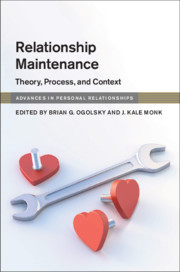Book contents
- Relationship Maintenance
- Advances in Personal Relationships
- Relationship Maintenance
- Copyright page
- Contents
- Tables
- Figures
- Contributors
- Part I Introduction
- Part II Theories of Relationship Maintenance
- 2 Interdependence Perspectives on Relationship Maintenance
- 3 An Evolutionary, Life History Theory Perspective on Relationship Maintenance
- 4 Relationship Maintenance from an Attachment Perspective
- 5 Uncertainty Perspectives on Relationship Maintenance
- 6 The Self-Expansion Model and Relationship Maintenance
- Part III Processes of Relationship Maintenance
- Part IV The Social Context of Relationship Maintenance
- Part V Conclusion
- Index
- References
2 - Interdependence Perspectives on Relationship Maintenance
from Part II - Theories of Relationship Maintenance
Published online by Cambridge University Press: 02 December 2019
- Relationship Maintenance
- Advances in Personal Relationships
- Relationship Maintenance
- Copyright page
- Contents
- Tables
- Figures
- Contributors
- Part I Introduction
- Part II Theories of Relationship Maintenance
- 2 Interdependence Perspectives on Relationship Maintenance
- 3 An Evolutionary, Life History Theory Perspective on Relationship Maintenance
- 4 Relationship Maintenance from an Attachment Perspective
- 5 Uncertainty Perspectives on Relationship Maintenance
- 6 The Self-Expansion Model and Relationship Maintenance
- Part III Processes of Relationship Maintenance
- Part IV The Social Context of Relationship Maintenance
- Part V Conclusion
- Index
- References
Summary
How do people maintain their closest relationships? In this chapter, we present an interdependence account of how people maintain their relationships with others. Interdependence theory, first articulated by Thibaut and Kelley, was formulated to explain how people choose among potential courses of action in interdependent situations featuring problems of actor coordination and decision-making. Because romantic partners are often faced with daily choices within their relationship (e.g., Should we go to the movie my partner wants to see rather than what I want to see? Should I stay in this relationship or pursue an alternate?), interdependence theory is well suited for understanding relationship maintenance processes. We begin by discussing why relationship maintenance is necessary. We then review the set of processes – behavioral and cognitive – that help keep interdependent relationships intact, despite the fact that situational actors must adapt to constantly changing situations. Central to these processes is one’s commitment to a relationship, which, once established, causes maintaining a relationship to become an automatic, default option under ordinary circumstances.
Keywords
- Type
- Chapter
- Information
- Relationship MaintenanceTheory, Process, and Context, pp. 15 - 28Publisher: Cambridge University PressPrint publication year: 2019
References
- 2
- Cited by



